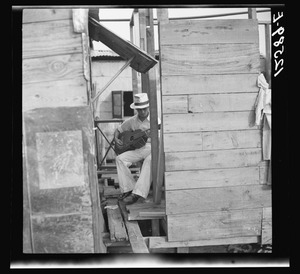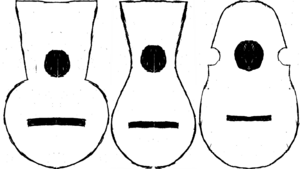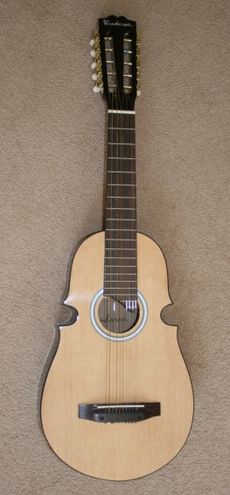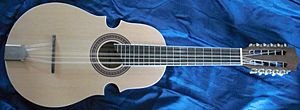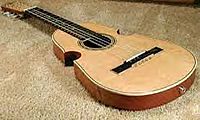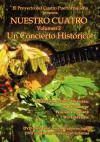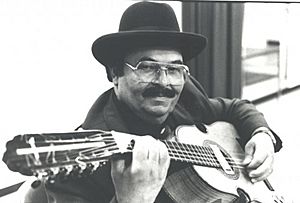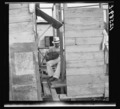Puerto Rican cuatro facts for kids
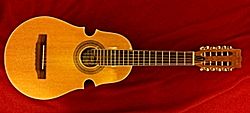
A Puerto Rican cuatro strung for left-handed playing (with lower and thicker strings to viewer's right)
|
|
| String instrument | |
|---|---|
| Classification | String instrument |
| Hornbostel–Sachs classification | (Composite chordophone) |
| More articles | |
| Tiple (Puerto Rico), Bordonúa | |
The Puerto Rican cuatro is the national instrument of Puerto Rico. It is a string instrument from the lute family, like a guitar. But its shape is more like a violin. The word cuatro means "four". This is because the first Puerto Rican cuatro had only four strings.
Today's cuatro has ten strings. These strings are in five pairs. They are tuned from low to high: B3 B2, E4 E3, A3 A3, D4 D4, G4 G4. The bottom two pairs have strings tuned an octave apart. The top three pairs have strings tuned exactly the same. The playing part of the string is about 500-520 millimeters long.
The cuatro is the most famous of three instruments. These instruments make up the Puerto Rican jíbaro orchestra. The other two are the tiple and the bordonúa.
Someone who plays the cuatro is called a cuatrista. Many great musicians have played this instrument. Some famous ones include Andrés Jiménez, Edwin Colón Zayas, Yomo Toro, Iluminado Davila Medina, and Maso Rivera.
Contents
History of the Cuatro
We don't know much about where the cuatro first came from. But most experts believe it has been in Puerto Rico for about 400 years. It is most like a Spanish instrument called the vihuela poblana. This old instrument had four pairs of strings, making eight strings in total. It is also similar to the Spanish laúd, especially those from the Canary Islands.
There was an "old cuatro" (cuatro antiguo) with four single strings. Then came one with eight strings in four pairs. After that, the modern cuatro with five pairs of strings appeared. Even with its name, the exact beginnings of the cuatro are still a bit of a mystery.
Types of Puerto Rican Cuatros
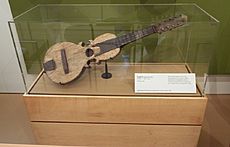
There are three main types of Puerto Rican cuatros:
- The four-string cuatro antiguo
- The eight-string "Southern" cuatro
- The ten-string cuatro "moderno"
The Four-String Cuatro Antiguo
This was the first Puerto Rican cuatro. It was carved from a single piece of wood. It used four strings made from animal guts. This instrument might have come from the vihuela poblana. It was mostly used to play jíbaro music.
The Eight-String "Southern" Cuatro
This cuatro developed from the older four-string version. It was built more like a guitar. It had four pairs of steel strings. People used it to play salon music, like the mazurka, danza, waltz, and polka.
The Ten-String Cuatro "Moderno"
This cuatro came from the ten-string bandurria and laúd from Spain. It is also made from a single block of wood. It has five pairs of steel strings. This is the most common cuatro used today. It can play many kinds of music. This includes jíbaro music, salon styles, salsa, pop, rock, classical, jazz, and even American bluegrass.
Cuatro Shapes and Sizes
Cuatros come in different shapes for their sound boxes.
Sound Box Designs
- The antiguo design: This shape looks like an old keyhole. It is also called cuatro cuadrao or cuatro araña. This was the very first design, possibly 400 years old. Some ten-string cuatros are still made with this shape today.
- The aviolinado design: This shape looks like a violin. It is the most common shape you see today. Eight-string and ten-string cuatros started using this design in the 1800s.
- The dos puntos design: This shape looked like some old mandolins. It was first used in the 1800s in Yauco, Puerto Rico. Eight-string cuatros were made with this design.
- The tulipán design: This shape was like the antiguo design but with all curves, no straight lines. It looked like a tulip. Eight-string and ten-string cuatros with this design were made in the 1900s near Yauco and Ponce.
- The higuera design: This is the rarest shape. The sound boxes were made from rounded gourds instead of wood. They looked like an organic oval. Four-string cuatros were made this way in the 1800s by enslaved Africans in Puerto Rico. Now, they are made with ten metal strings and often have carvings on their backs.
- Many other unique designs also exist.
Cuatro Variants
In the 1950s, people tried to create a "classical" group of cuatros. They wanted different sizes to play the roles of violins, violas, cellos, and double basses in an orchestra. Cuatros with the aviolinado shape were made in four sizes:
- Cuatro Soprano
- Cuatro Alto
- Cuatro Tradicional (the standard one, also called Cuatro Tenor)
- Cuatro Bajo (Bass Cuatro)
All of these had ten strings and were tuned in fourths. This project was not very successful. Today, most of these special cuatros are rare. The cuatro tradicional is still the standard instrument.
There is also a Cuatro Lírico ("lyrical cuatro"). It is about the size of the Tenor but has a deep, jelly-bean shaped body. A Cuatro Sonero has fifteen strings in five groups of three strings each. A Seis is a standard Cuatro Tradicional with an extra two-string group, making it twelve strings in six groups.
Cuatro Orchestras of Puerto Rico
The first cuatro orchestra was called the orquesta jíbara. It had different string instruments:
- Puerto Rican Tiple
- Cuatro Tradicional
- Bordonúa
In the 1950s and 1960s, at least two types of "classical" cuatro orchestras were formed:
- Primero Cuatro Concertino
- Segundo Cuatro Concertino
- Cuatro Bajo
- Cuatro Rítmico
- Cuatro Tradicional
Or:
- Cuatro Soprano
- Cuatro Tenor
- Cuatro Alto
- Cuatro Bajo
As mentioned, most of these special instruments are rare now. These classical groups are also rare. However, there have been recent efforts to bring back the orquesta jíbara.
"The Puerto Rican Cuatro Project"
William Cumpiano and Christina Sotomayor started The Puerto Rican Cuatro Project. This is a non-profit organization. It works to keep the traditions around Puerto Rico's national instrument alive. They do this by collecting, sharing, and saving the cultural memories of Puerto Rican music. This includes traditional stringed instruments and musicians. The project also helps promote the Puerto Rican décima verse form. This is a traditional song style created by famous troubadours, both past and present.
Cumpiano, with Sotomayor and Wilfredo Echevarría, made two DVD documentaries for The Cuatro Project:
- OUR CUATRO Vol. 1: This was the first full-length movie about the cuatro and its music.
- OUR CUATRO Vol. 2: A Historic Concert
Cumpiano and researcher David Morales also made another DVD documentary. It was called THE DÉCIMA BORINQUEÑA: An ancient poetic singing tradition. Myriam Fuentes directed it. The money from these recordings helps with the research and documentation of The Puerto Rican Cuatro Project.
Cuatro in Popular Music
Jon Anderson from the band Yes used a cuatro on their album Tormato. The album notes mistakenly called it an Álvarez ten-string guitar. Puerto Rican singer-songwriter Christian Nieves played a cuatro on the 2017 hit song "Despacito". This song was by Luis Fonsi and Daddy Yankee. The cuatro, set up for left-handed playing, can be seen at 3:32 in the song's official music video: https://www.youtube.com/watch?v=kJQP7kiw5Fk. This video became the most-watched on YouTube in August 2017.
Images for kids
-
An antique Cuatro (c. 1900 - 1915) on exhibit in the Musical Instrument Museum of Phoenix
See also
 In Spanish: Cuatro puertorriqueño para niños
In Spanish: Cuatro puertorriqueño para niños


